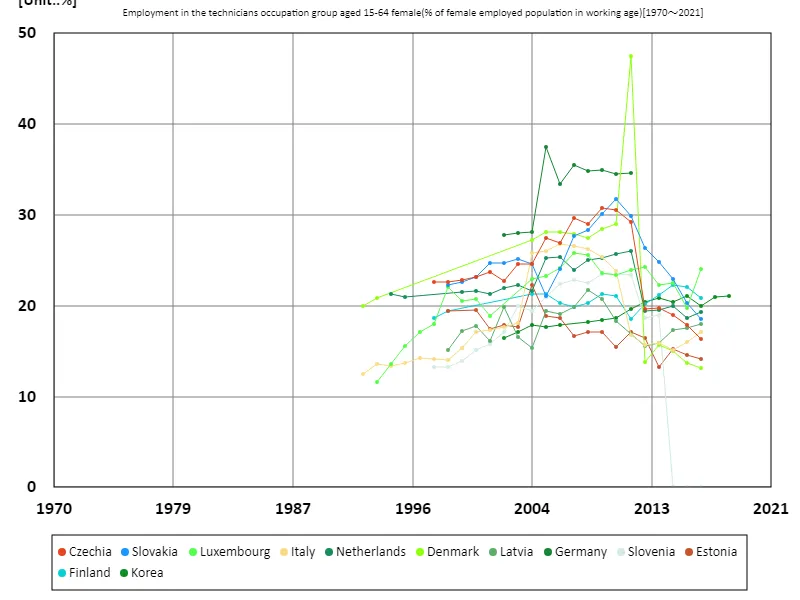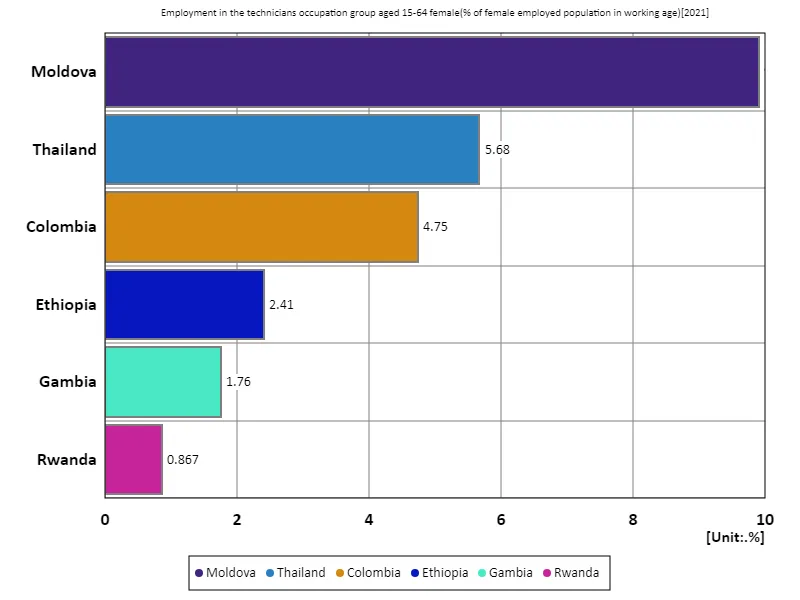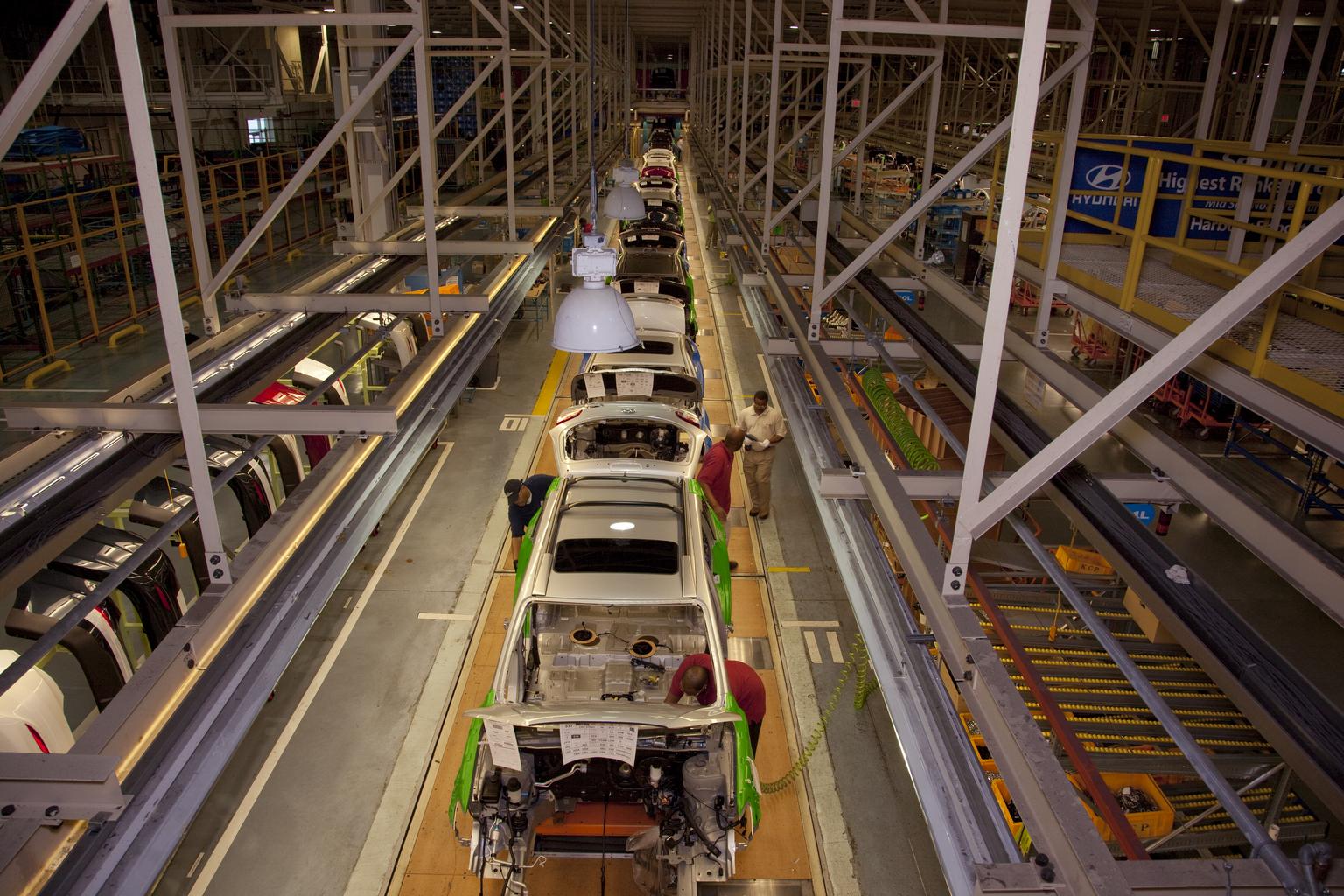- Abstract
- Employment rate for women aged 15-64 in the technical occupations (percentage of working-age female employment population)
- Employment rate of women aged 15-64 in the skilled occupations sector (percentage of working-age female employment population) (Worldwide)
- Employment rate of women aged 15-64 in skilled occupations (percentage of working-age female employment population) (World, latest year)
- Reference
Abstract
Based on the data, employment rates in the technical sector for women aged 15-64 tend to vary significantly across countries. South Korea’s high employment rate of 21.1% in 2018 is likely due to policies and corporate initiatives to promote female participation in technology fields. In general, more women are entering the labour market in developed countries, particularly in technical occupations. Meanwhile, in developing countries, the proportion of women in technical occupations is relatively low, sometimes due to a lack of education and training opportunities. Recent trends show an increase in women’s involvement in STEM (science, technology, engineering, and mathematics) fields globally, but gender gaps still exist. To close this gap, more educational opportunities and workplace supports are needed.
Employment rate for women aged 15-64 in the technical occupations (percentage of working-age female employment population)
Looking at data from 1992 to 2018, we see notable fluctuations in female employment rates in the technical sector. Denmark’s peak of 47.5% in 2011 was the result of successful government policies and corporate initiatives. However, the subsequent decline has been influenced by changes in technology fields, fluctuations in the labor market, and the diversification of women’s career choices. Denmark’s current 27.7% figure suggests that women’s share of technical occupations overall is stabilising, with the labour market maturing and them moving into other sectors. On the other hand, other countries are also gradually encouraging women to enter technical roles, and globally, the proportion of women in STEM fields is on the rise, but gender imbalances still remain. In order to further increase the proportion of women in technical positions, improvements in education and working environments are required.


The maximum is 47.5%[2011] of Denmark, and the current value is about 27.7%
Employment rate of women aged 15-64 in the skilled occupations sector (percentage of working-age female employment population) (Worldwide)
Looking at data from 1991 to 2019, there is significant variation in employment rates in the technical sector for women aged 15-64. Denmark’s record of 47.5% in 2011 marked the peak of female participation in tech jobs, reflecting proactive policy and corporate initiatives at the time. However, Denmark’s current figure of 27.7% represents a subsequent decline, likely due to a shift towards non-technical occupations and fluctuations in the labour market. Over this period, the proportion of women in technical jobs has been increasing, but the decline since the peak may be due to changes in the industry and diversification of occupations. For example, as digital technology evolves and globalization progresses, employment opportunities are increasing in new fields outside of technology, expanding women’s options. Changes in education policies and workplace environments in each country are also having an impact, and women’s participation in the STEM (science, technology, engineering, and mathematics) fields remains an important issue. In order to further encourage women to enter technical professions, continued support from educational institutions and companies is needed.


The maximum is 47.5%[2011] of Denmark, and the current value is about 27.7%
Employment rate of women aged 15-64 in skilled occupations (percentage of working-age female employment population) (World, latest year)
According to 2021 data, Moldova has the highest employment rate in the skilled sector for women aged 15-64 at 9.91%, compared to an overall average of 4.23% and a total of 25.4%. The data shows that female employment rates in technology roles remain low, particularly in the 4% range in many countries. Moldova’s high ratio indicates a relatively high level of female participation in the technical sector in the country, but it is an exception to the overall trend. The low global average suggests that women’s entry into technical professions remains a challenge, likely due in large part to gender gaps in education and the workplace. In particular, the report emphasizes the importance of promoting STEM fields in educational institutions and implementing diversity measures within companies to address gender disparities in technical occupations. Overall, while the employment rate of women in technical occupations is gradually improving, it remains low in many countries, calling for further policies and support. To further encourage women to enter technology roles, structural changes are needed in both education and the workplace.


The maximum is 9.91% of Moldova, the average is 4.23%, and the total is 25.4%



Comments